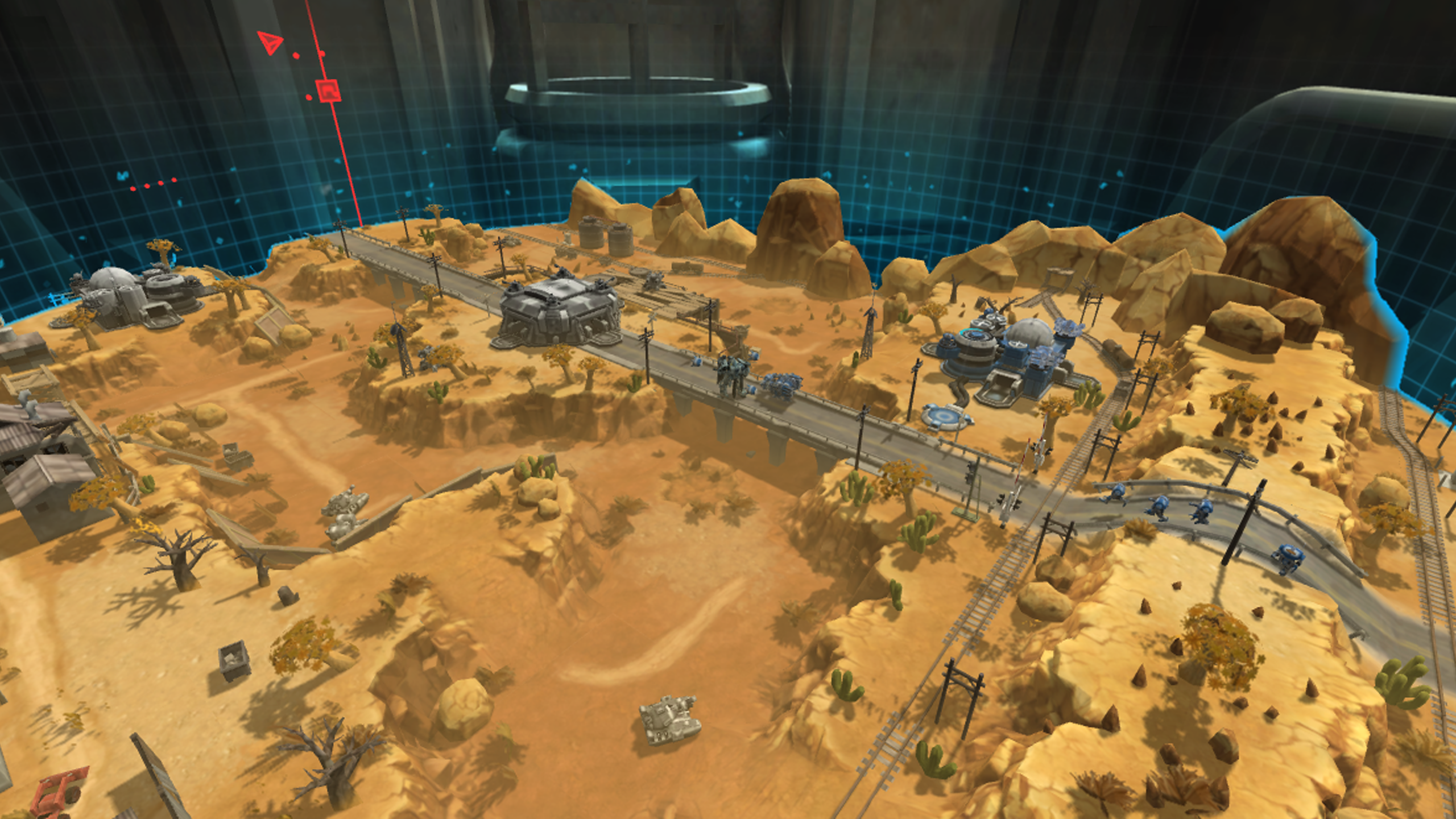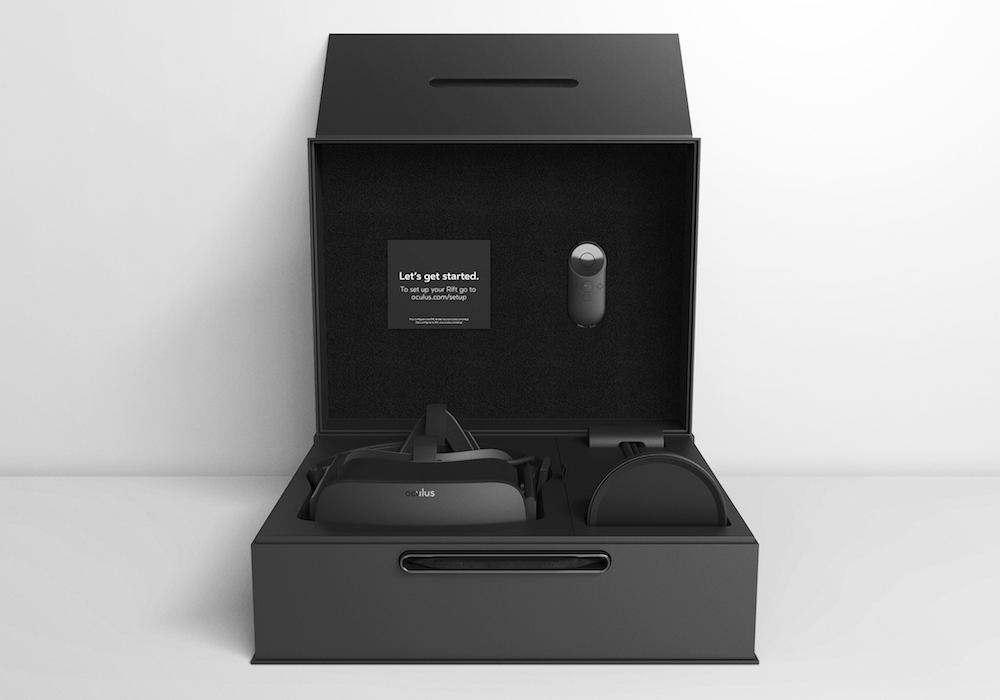THE REVIEWS
On Monday, the first units of the Oculus Rift shipped to pre-orderers and Kickstarter backers who had contributed enough for a commercial launch unit, prompting the tech and gaming industry to issue reviews for the hardware. It surprises me how many discuss how great the box is that it came in; and in their defense, it's a very nice-looking box. Discussions of the hardware itself—a screen for each eye at 1200×1080 pixels, a refresh rate of 90hz, a 13-foot cable, a camera for positional tracking, remote, and an Xbox One controller—was generally followed with advice on how to make the thing work on your particular noggin' once you've got it in your house.
All that, of course, on a computer that can actually run it. Complaints about the cost of the computer were common, even while Oculus loaned many reviewers a custom-built $950 ASUS machine set to the recommended specs. Ben Kuchera's review at Polygon noted that while testing had proven that his personal rig could run every one of the launch games at the benchmark of 90fps, due to differing specs, it produced a message letting him know his hardware was underpowered every time he tried to launch a game. If Oculus has provided stats higher than what's necessary for their launch window, it may be a while before tech and gaming outlets are able to reveal what graphics cards and processors below spec run the hardware well enough at a lower cost.
Without a doubt, the weirdest piece of coverage I've seen for the Oculus Rift is CNET's Special Report on its release, which is half-review, half-tonal poem, complete with a video that's practically an advertisement for a VR-laden future, with some guy pretending to be in VR while out at San Francisco's sight-seer's Pier 14. Perhaps more amusing are the reviews from outside the tech and gaming industries: The USA Today reviewer gave it to his 9-year-old son to try (who loves it), and both The Wall Street Journal and the New York Times lament that all that seems to be available for it are those gosh-darn video games, preferring other interactive content or film-like experiences. The Times reviewer was upset you had to have a PC at all, seeming to think that was anachronistic in this tablet/smart phone driven age we all clearly live in.
THE GENERAL VERDICT
However, one thing all the reviewers seemed to share was the opinion that VR is coming, it's gonna be big, and then asked the question of whether or not you should buy a Rift. Those clearly in VR's corner obviously went for it—I mean, do you expect a website like Road to VR not to come out for purchasing an Oculus Rift?
Some hedged that consumers should try the current device but wait for version 2.0. The general consensus of the rest seemed to be: Yes, if you have the money. If you don't, wait for the tech to come down in price, because everything will get better from this point forward.
I agree with this statement with a few caveats I'll mention in the sections below.

THE HEADSET
As a note, GR was not sent an Oculus Rift, and we have not purchased one, so the following is based largely on the Oculus Rift event coverage during GDC, where I spent an entire day with the final release version of the device.
In terms of comfort, the Oculus Rift is surprisingly balanced for something bulky that you strap to the front of your face. Some people who need glasses still have issues with getting them inside, especially if they are a bulkier pair. The fit is fairly snug, placing the most stress on the back and top of the head—people demoing the hardware at GDC told users to "put it on like a baseball cap," but it's more like putting on a baseball helmet, and any attempt to put it on as recommended (or worse, not let me put it on myself) actually brushed my long hair in front of my face, often obscuring one of the lenses.
There's a general "sweet spot" that can take a moment to find where everything is in focus within the headset, making the adjustment before tightening the velcro straps. The width of the lenses can be adjusted to fit different eye-widths—a feature that is relatively new in the device's development cycle—using a set of sliders beneath each lens on the bottom of the headset.
Visually, the experience with the Oculus Rift looks great and is competitive with the screen resolutions for both the Playstation VR and the HTC Vive. The closeness of the screen to the viewer, plus the wide visual angle, does produce a minor "screen door effect," where the individual pixels can create a chunky aliased effect—like if you were to hold a cell phone right next to your face, which is essentially where the screens for these devices are from.
There are some solutions being proposed for this. The Avegant Glyph head-mounted display uses millions of micro-mirrors to reflect the image onto the retina, which gets rid of the problem and creates incredibly vibrant color, but at the cost of reduced resolution and viewing angle. IMMY has a patent for a system that would project the image directly onto the eye—à la the system in Neal Stephenson's landmark cyberpunk novel Snow Crash—with similar benefits. If either is successful, I'd expect them to be purchased or the tech licensed, and folded into future Oculus, HTC/Valve, or Sony solutions.
All-in-all the Oculus Rift is on par with the other commercial headsets due to be released this year, unless they manage to pull a rabbit out of their hats at the last minute.
THE GAMES
By far the biggest issue that all reviews had is that most of the games do not offer experiences that you can't get outside of VR. I tend to agree, with the caveat that the games that do offer those solutions are mostly tied to the Oculus Touch motion controllers, which won't be released until later this year.
Ther are great Touch controller games like Sanzaru's VR Sports, where in a football mini-game as a receiver, you have to accurately place your hands to catch the ball or use the correct motion to make a 3-point shot in basketball training. Another is Fantastic Contraption, a physics-based puzzler, which also ships with the HTC Vive, where you build simple machines to move a ball from one area to another while dealing with gaps and obstacles. Dead and Buried, an online arcade multiplayer shooter (à la Time Crisis), has you in an undead Wild West shootout, where you literally duck behind cover, was fun as well. Crytek's gorgeous mountain-climbing simulator, The Climb, was notable in that it was clearly a game that was absolutely completely suited to Touch controls, but it was relying on the Xbox One controller instead, although the developers made assurances that Touch controls were on the way.
All of these games were doing things that you can only really do in VR or AR, in terms of directly interacting with objects or the environment itself, where the closest approximation from traditional games is something like Dance Central, but if you were actually on the dance floor, seeing the crowd around you. Speaking of Harmonix, they demoed a version of Rock Band VR, but it felt surprisingly limited, due partially to the lack of band support members as well as the scrolling guitar finger positions being fixed to the audio monitor in front of you—while the venue was live around you—forcing you to look down and away from the crowd (something the Harmonix reps said they would have different options for when they it show at E3).
Traditional games had varying degrees of success. Lucky's Tale, which comes bundled with the Rift, is a third-person platformer where you hover above and around the titular character, rewarding you for peering around the environment to find secret platforms. Chronos fixes the position of where you are looking from in static environments, giving it an Onimusha feel that keeps it from causing nausea but also feels distant from the action. I wasn't able to play a present build of Insomniac's Edge of Nowhere, but it appeared to have a very traditional feel to it, which while cool, didn't seem to rely on the VR elements that much.
 Airmech Command's area limits show the virtual space's command center.
Airmech Command's area limits show the virtual space's command center.
The best tactic for most games seem to be those that lock you into a fixed environmental perspective, or vehicle. EVE: Valkyrie is amazing at this, placing you in the cockpit of a space fighter capable of looking at everything around you in the confined space, tying missile locks to what you're looking at outside of it. Carbon Games' Airmech Command offers a novel RTS experience, where it's like looking down at a tabletop game-board where everything is moving in real time, and camera movement jumps to where your avatar airmech is, on the board, with a button press.
Among the most successful in terms of immersion is Ubisoft's Eagle Flight. As a soaring eagle, directional controls are determined by tilting your head in one direction or another with the controller used to determine speed and to fire a sonic scream blast. While Eagle Flight didn't seem to have very deep gameplay mechanics, and taking off the headset after playing was disorienting, as if you had truly spent time as some other being and had to acclimate to being human again. How much I would play it, with game modes limited to races, attack challenges, and multiplayer capture the prey (flag) matches, is another question altogether, though. It felt much more like a very versatile demo than an actual game.
With the Touch controllers release a ways off, the best experiences I had playing the Oculus Rift feel like they are still distant as well. That said, my time with the Touch controllers had me praising them as the best of the three motion control systems, more natural feeling than the HTC Vive's controllers, and more precise and ergonomic than Sony's Move controllers.
MOVEMENT
Without a doubt, The Oculus Rift's single-tracking camera limits the area in which you can play the games, giving you a smaller area of play than the HTC Vive, and making it competitive with Sony's Playstation VR, which has similar limitations. At the preview event, they had a rubber mat placed on the floor to help let players know where the edges of the playable area were. However, within the space, which seemed to be about a five-to-six foot square, you could move around, crouch, sit, and basically interact however you wanted, provided the game was designed for it.
The constrictions of the space do limit the kind of design possible, making the interactions more static than the room-sized VR available with the HTC Vive. This wasn't always the worst thing, as I played several Vive demos at GDC where having a limited open space was surprisingly frustrating. I constantly checked myself after watching other people walk straight into walls in the real world, because the area was not perfectly calibrated.
While limited in space, a game like Dead and Buried made great use of the static area, and the way the game was able to extrapolate, from head and Touch controller motion and position the data to create an avatar that synced with their body position, was truly an extraordinary example of the VR experience. Your multiplayer opponents moved and interacted like real people, though their torsos and legs were a little stiff. Experiences like that make VR truly unlike any other experience.

CONCLUSION
Like the conclusions of the reviews I mentioned in the earlier section, I would recommend the Oculus Rift if you can afford it. I currently cannot. If you have the money and wanted to choose between the three options, a lot of it comes down to deciding what kind of gameplay/virtual experience you want.
For sit-down experiences in the PC space, I would choose The Oculus Rift, especially because of the superb Touch controllers, when they finally release. If you have the space for a room-sized VR experience, HTC Vive offers the greatest sense of immersion in being able to literally walk around a virtual space.
The cheapest in terms of overall hardware is Playstation VR, and every game for the platform will have exactly the same specifications due to the console's limitations. I'm likely to pick this up because I was told Media Molecule's Dreams will have Playstation VR support, and I'd love to paint 3D game environments into existence in real time. There's also the current range of cell phone VR products and experiences, which in addition to the cost of the phone, can be as little as $6 for a Google cardboard set-up—or the Samsung and Oculus' $99 Gear VR—but offer a limited use of the tech.
Are you convinced? If so, what VR experiences are you excited for?











